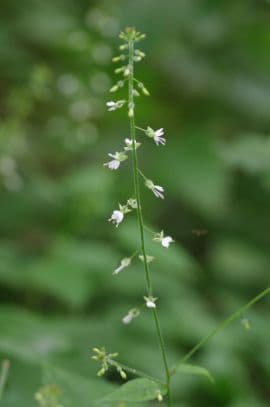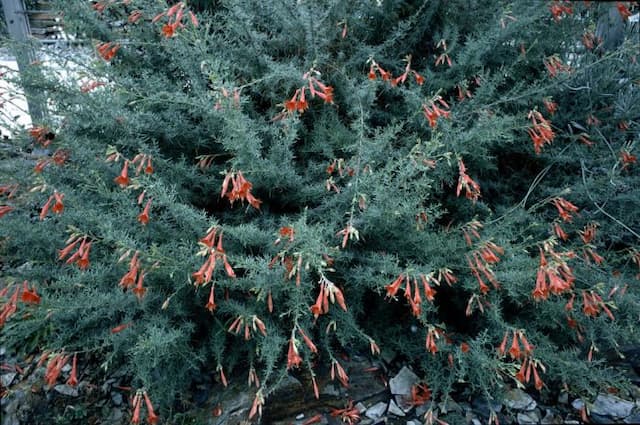Sundrops Oenothera fruticosa subsp. glauca 'Sonnenwende'

ABOUT
The plant known as 'Sonnenwende', is a variety characterized by its robust, bushy growth habit. It boasts a rich display of bright, sunny yellow flowers which gives the plant its common name. The flowers have a unique saucer-like shape that opens out to reveal a delicate arrangement of petals, often standing in stark contrast against the foliage. The leaves of the 'Sonnenwende' are slender and lance-shaped, exhibiting a blue-green hue which forms a striking backdrop to the luminous blooms. The foliage tends to become reddish as the season progresses, adding further to the plant's ornamental appeal. The stems are sturdy, holding the flowers aloft so that they can sway gently in the breeze. The blooming period for this plant is notable for its length, providing a show of color that spans from late spring and well into summer. Overall, 'Sonnenwende' has a visual grace, with its bright flowers and complementary foliage, that can add sunshine to any garden corner.
About this plant
 Names
NamesFamily
Onagraceae
Synonyms
Sundrops, Narrowleaf Evening Primrose, Southern Sundrops, Wild Bee's Friend
Common names
Kneiffia fruticosa 'Sonnenwende', Kneiffia linearis 'Sonnenwende', Oenothera tetragona var. glauca 'Sonnenwende'.
 Toxicity
ToxicityTo humans
The plant commonly known as Sundrops is not widely recognized as poisonous to humans. There are no well-documented cases or studies indicating that Oenothera fruticosa subsp. glauca 'Sonnenwende' poses any significant risk of toxicity when ingested by humans. However, as with any plant, it is generally advisable to avoid ingesting it unless it is known to be edible, as individual reactions can vary.
To pets
Sundrops, also known as Oenothera fruticosa subsp. glauca 'Sonnenwende', is not known to be toxic to pets. There are no significant reports or studies that suggest this plant poses a risk of poisoning to common household pets such as dogs or cats if they ingest it. However, it's always important to monitor pets and prevent them from eating plants not specifically intended for their consumption, as individual animals may have different sensitivities or allergic reactions.
 Characteristics
CharacteristicsLife cycle
Perennials
Foliage type
Deciduous
Color of leaves
Green
Flower color
Yellow
Height
2-3 feet (60-90 cm)
Spread
2-3 feet (60-90 cm)
Plant type
Herb
Hardiness zones
5
Native area
North America
Benefits
 General Benefits
General Benefits- Attracts Pollinators: Oenothera fruticosa subsp. glauca 'Sonnenwende', commonly known as the sundrops, is highly attractive to bees, butterflies, and other beneficial insects, which are essential for pollination.
- Drought Tolerance: Sundrops have good drought tolerance once established, making them suitable for xeriscaping and dry garden conditions.
- Low Maintenance: This plant requires minimal care once established, making it an excellent choice for gardeners looking for low-maintenance landscaping options.
- Long Blooming: Sundrops produce vibrant yellow flowers that bloom for an extended period, usually from early summer to early fall, providing long-lasting color in the garden.
- Wildlife Habitat: The plant offers a habitat and food source for wildlife, as various insects use it for nectar and birds may use it for cover.
- Easy Propagation: Sundrops can easily be propagated by division or cuttings, allowing gardeners to spread them to other parts of the garden or share with others.
- Erosion Control: With its spreading habit and root system, sundrops can help stabilize soil and prevent erosion on slopes and banks.
- Night Blooming: Some flowers open in the evening, which can add interest to a night garden and provide a food source for nocturnal pollinators.
 Medical Properties
Medical PropertiesThis plant is not used for medical purposes
 Air-purifying Qualities
Air-purifying QualitiesThis plant is not specifically known for air purifying qualities.
 Other Uses
Other Uses- Sundrops can be used to create natural dyes for fabrics, with different parts of the plant yielding a variety of colors.
- The stems and leaves can be included in compost as green matter to provide nitrogen and improve the compost quality.
- The sap of the plant can sometimes be used as a mild adhesive in emergency situations or for small craft projects.
- Dried plant parts are sometimes used in potpourri mixes, adding a subtle fragrance and a touch of color to the mixture.
- Sundrops are used in garden design as border plants, providing a visual transition between different garden sections or features.
- The flowers can be used as a natural confetti for outdoor celebrations, being both biodegradable and colorful.
- Pressed sundrop flowers can be used in botanical art and craft projects for decoration and design elements.
- Plant enthusiasts sometimes use sundrop seed pods for seed swaps, sharing the beauty of the plant with others.
- Dry stems can be used as natural kindling for starting campfires or outdoor fireplaces due to their flammability.
- Sundrop plants can be planted strategically in the landscape to support local wildlife, such as providing nectar for pollinators.
Interesting Facts
 Feng Shui
Feng ShuiThe Sundrops is not used in Feng Shui practice.
 Zodiac Sign Compitability
Zodiac Sign CompitabilityThe Sundrops is not used in astrology practice.
 Plant Symbolism
Plant Symbolism- Survival and Resilience: Oenothera fruticosa, commonly known as the Sundrops, tends to grow in tough environments, symbolizing the ability to survive and thrive in challenging conditions.
- Peace and Tranquility: The bright, sunny flowers of Sundrops can be seen as a representation of peace and calmness, offering a sense of tranquility to those who behold them.
- Healing: Traditionally, sundrops have been used in herbal medicine, suggesting a symbolism of healing and restoration.
- Patience: Sundrops take some time to bloom and grow, which can symbolize patience and the notion that good things come to those who wait.
- Joy and Cheerfulness: With their radiant and cheerful yellow blooms, Sundrops are often associated with feelings of joy and the brightening of spirits.
 Water
WaterSundrops, commonly known as the common name for Oenothera fruticosa subsp. glauca 'Sonnenwende', prefer to be watered deeply but infrequently to encourage deep root growth. During active growth in the spring and summer, watering once a week with about one to two gallons of water per plant is adequate, depending on the climate and soil moisture. It's crucial to allow the soil to dry out between waterings to prevent root rot. In the fall and winter, reduce the watering frequency as the plant goes dormant and requires less moisture.
 Light
LightSundrops thrive best in full sun conditions, receiving at least six to eight hours of direct sunlight each day. Position them in a spot where they can soak up plenty of light without being shaded by taller plants or structures, as ample sunlight is essential for abundant flowering and healthy growth.
 Temperature
TemperatureSundrops are fairly temperature-hardy and can tolerate a range across various climates. They survive in temperatures as low as 20°F during dormancy in winter months but prefer a range between 60°F to 75°F during the growing season for optimal growth. Avoid exposing the plant to extreme heat above 90°F or frosts that can damage it.
 Pruning
PruningSundrops should be pruned to remove spent blooms and encourage a second flush of flowers, shape the plant, and promote vigorous growth. Deadheading, or the removal of old flowers, can be done throughout the blooming season. After the first killing frost, cut back the plants to ground level to prepare for winter. The best time for more extensive pruning is early spring before the new growth begins.
 Cleaning
CleaningAs needed
 Soil
SoilThe Sundrops prefers well-draining soil with a neutral to slightly acidic pH of 5.5 to 7. The best soil mix should contain a balance of loam, sand, and compost to ensure good drainage and fertility.
 Repotting
RepottingSundrops typically do not require frequent repotting and should be repotted every 2-3 years or when it is evident that the plant has outgrown its current container.
 Humidity & Misting
Humidity & MistingSundrops are tolerant of a wide range of humidity conditions and do best in average room humidity, without the need for any special humidity adjustments.
 Suitable locations
Suitable locationsIndoor
Place Sundrops in bright, direct light and avoid overwatering.
Outdoor
Plant in full sun, well-draining soil; water regularly, less during winter.
Hardiness zone
4-9 USDA.
 Life cycle
Life cycleSundrops (Oenothera fruticosa subsp. glauca 'Sonnenwende') begin their life cycle as seeds, which, when sown in a well-drained soil and exposed to light and warmth, will germinate. Seedlings develop a root system and foliage, after which they enter a vegetative stage, growing leaves and stems actively during the spring and summer. As the plant matures, it starts to produce distinctive yellow flowers typically from late spring to early summer, attracting pollinators for sexual reproduction. After pollination, the flowers develop into capsules containing seeds, completing the reproductive cycle by late summer or early autumn. Once the seeds are dispersed, the parent plant will generally die back in winter, with the perennial root system surviving to sprout again the following spring. Over time, Sundrops can also spread vegetatively through rhizomes, expanding their presence in their growing area.
 Propogation
PropogationPropogation time
Spring-early summer
The most popular method of propagating the Sundrops, which is the common name of Oenothera fruticosa subsp. glauca 'Sonnenwende', is through seed sowing. Seed propagation is typically done in the spring after the threat of frost has passed. To propagate Sundrops by seeds, one should first collect the seeds from the ripe seed capsules of an existing plant. Sow the seeds directly onto a well-drained soil mix in pots or flats, covering them lightly with soil. Keep the soil moist until germination, which generally occurs within two to four weeks. Once the seedlings have developed several true leaves and are large enough to handle, they can be transplanted into individual pots or into the garden in a location that receives full sun to partial shade.









